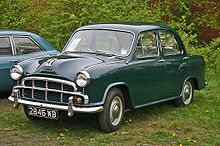AMBASSADOR- THE ROYAL CAR OF INDIA



Ambassador Nova
Ambassador Classic



The Hindustan Ambassador is a car manufactured by Hindustan Motors of India. It has been in production since 1958 with few modifications or changes and is based on the Morris Oxford III model, first made by the Morris Motor Company at Cowley, Oxford in the United Kingdom from 1956 to 1959.
Despite its British origins, the Ambassador is considered as a definitive Indian car and is fondly called "The king of Indian roads". The automobile is manufactured by Hindustan Motors at its Uttarpara plant near Kolkata, West Bengal. Some prominent Indian politicians, such as Sonia Gandhi, use the Hindustan Ambassador.
When the Birla’s wanted a new model to replace their already old Hindustan models based on Morris Oxford Series II (Hindustan Landmaster), they scouted for the then-new Morris Oxford Series III. The car initially came with a side-valve engine but was later improved to an overhead-valve engine. Also the car at that point was quite an innovation with a fully enclosed monocoque chassis, which is why it is spacious inside.
Hindustan Motors Limited (HM), India's pioneering automobile manufacturing company and flagship company of the C.K. Birla Group, was established just before Indian independence, in 1942 by B.M. Birla. They began operations in a small assembly plant in Port Okha near Gujarat.
The Amby, as it is affectionately called, has been in continuous production since its inception, with very few changes to its frame.
In 1948, Hindustan Motors shifted its assembly plant from Port Okha in Gujarat to Uttarpara in West Bengal's Hooghly district and strengthened its manufacturing capacity in the automobile segment.
The 1954 Morris Oxford series II in India was licence-built at Uttarpara, (Hooghly dist.), West Bengal, three years after its debut in England and labelled as the 1957 Hindustan Landmaster. It had a rounded rear squab and a curvaceous sloping hood.
Engaged in the manufacture of the Ambassador, Contessa and utility vehicles like the Trekker, Porter and Pushpak, the plant also has to its credit, many innovations and improvements in the automobile industry in India. Hindustan Motors is the only manufacturing facility in the world to manufacture parts for Bedford trucks currently.


Ambassador Mark I to Mark IV
In 1957, all the tooling of the British Morris Oxford Series III was transferred to India. The car was renamed the Ambassador and series-production started in 1957.
Styling changes from the Morris Oxford series II (Landmaster) to Morris Oxford series III (Ambassador) included deep headlamp cowls and small rear wing "tail fins" – all the rage in 1956. The dashboard and steering wheel were completely redesigned. The Landmaster's flat-plane two-spoke steering wheel gave way to a stylish dished steering wheel with three spokes made-up of four wires per spoke, for the Ambassador. Also a new, dimpled hood made its debut. These models had a 1,489 cc side-valve BMC B petrol engine. In 1959 the side-valve engine was replaced by a 1489 cc, 55 bhp overhead-valve BMC B Series petrol engine.
Ambassador Nova
The Ambassador Nova was launched in 1989 in two variants – a 55 bhp petrol-powered Deluxe version and a 37 bhp diesel-powered Diesel DX version. Ambassador Nova had a newly designed steering wheel, new steering column, better brakes and electricals. It also had some cosmetic changes which included a new radiator grill.
Ambassador 1800 ISZ
In an attempt to increase its appeal, in 1992 another version was released. Dubbed the Ambassador 1800 ISZ, this model featured a 75 bhp 1,800 cc Isuzu engine and a five-speed gearbox, and also had the option of bucket seats, as opposed to the earlier bench seats. Also, the entire dashboard was redesigned. Instrumentation panels were shifted from the centre of the dashboard to the right, behind the steering wheel. Seat belts became mandatory.
Ambassador Classic
After the millennium renovation project at the Uttarpara Plant, the Ambassador was re-engineered and renamed the Ambassador Classic. The new model featured a redesigned dashboard, polyurethane seats, pull type door handles and the steering column gear lever was replaced by floor shift gears and had a tweaked up suspension. The higher end models featured servo assisted disc brakes and power assisted TRW steering.
AVIGO
The Avigo is the most radical revision of the venerated Ambassador, a part of a brand revitalisation kicked off in the middle of 2003. The change of name, a break from the Ambassador marque, indicated a different marketing strategy. The Avigo was launched in the summer of 2004. The revitalized lineup consisted of the Ambassador Classic of mid-2003, the Ambassador Grand of late-2003, and the aforementioned Avigo, designed by Manvindra Singh. Car enthusiasts, however, see this merely as a desperate attempt to claw back ever-dwindling market share.

ENGINE
In the early 1990s, the old Austin-designed B-Series OHV straight-4 BMC 1.5L petrol engine was replaced in favour of an Isuzu 1.8 litre engine and became the fastest production car in India, beating Fiats, and the Maruti Suzuki cars at that time. The engines currently available are the 1.8 L 75 bhp MPFI petrol engine and a 2.0 L 50 bhp Isuzu diesel engine.
In the late 1970s a limited batch of Mark III Ambassadors were produced with 1,700 cc engines.They were fitted with Constant Velocity SU side-draft carburettors of an earlier era instead of the more common indigenous Variable Velocity Solex down-draft units. The engine blocks of these cars had "1700" etched on them instead of the usual "1500". These were probably produced to handle the extra load of the piston-driven air conditioner compressors available in those days. The trim (metal beading) of these cars were a throwback to the sixties because they were chromeplated instead of aluminium.

No comments:
Post a Comment